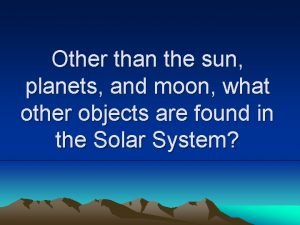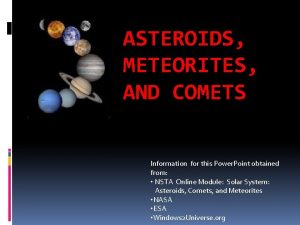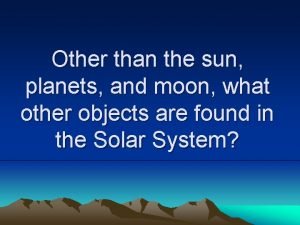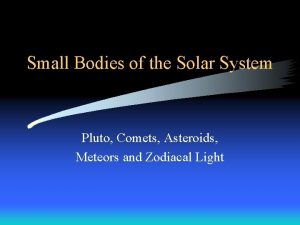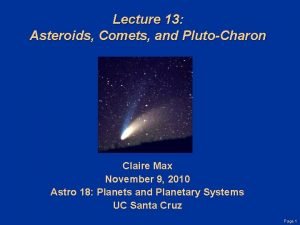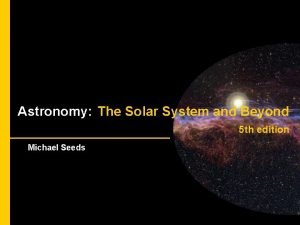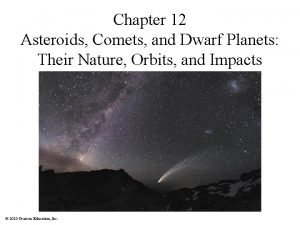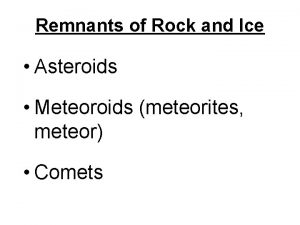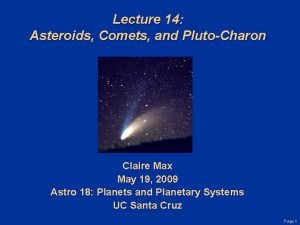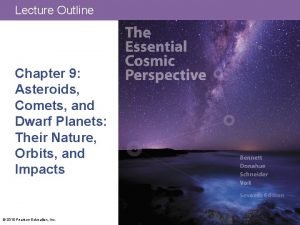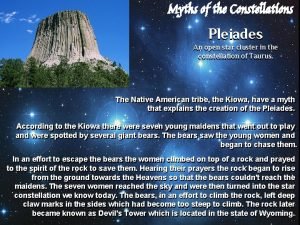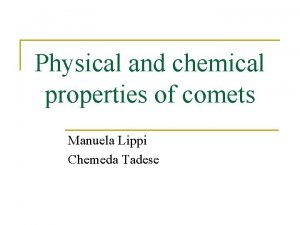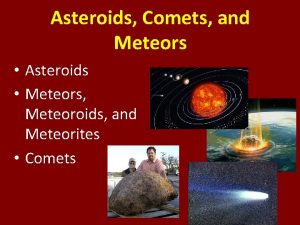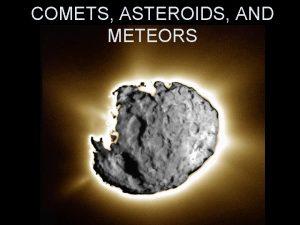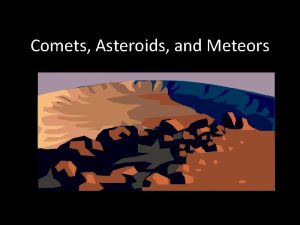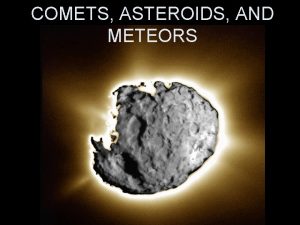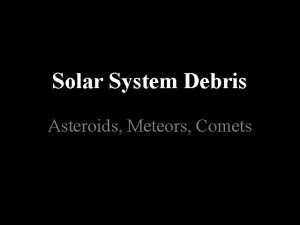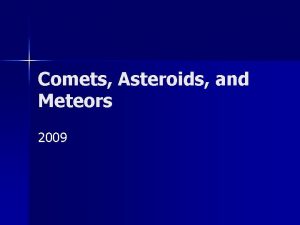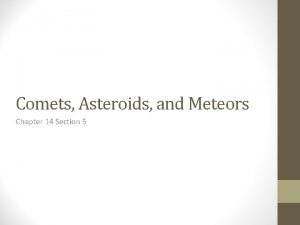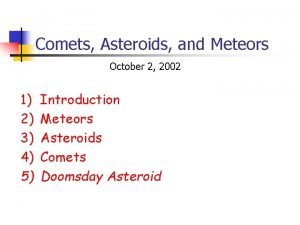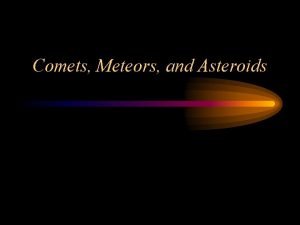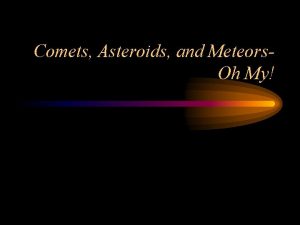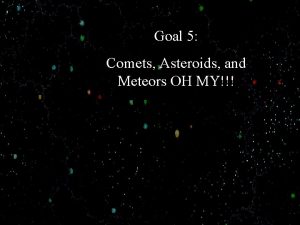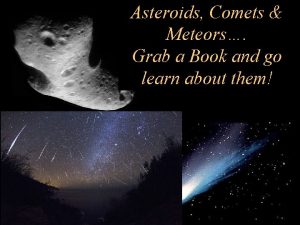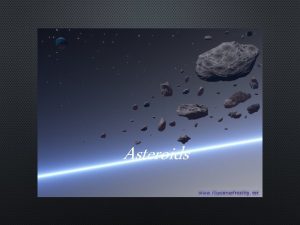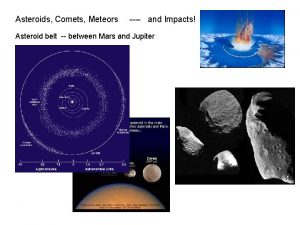Chapter 16 Section 5 Comets Asteroids and Meteors

















- Slides: 17

Chapter 16 Section 5 Comets, Asteroids, and Meteors

Ch 16 S 5 Essential Questions 1. What are the characteristics of comets? 2. Where are most asteroids found? 3. What are meteoroids and how do they form?


Comets • Farther our in space, near the edge of the solar system a huge cloud formed. • This cloud is believed by some astronomers to be the home of comets.

Minor Members of the Solar System Comets A comet orbits the sun. A comet is made up of ice, dust, and small rocky particles. You can think of a comet as a “dirty snowball. ” Comets are small bodies made of rocky and metallic pieces held together by frozen gases. Comets generally revolve about the sun in elongated orbits. Comets are loose collections of ice, dust, and small rocky particles whose orbits are usually very long, narrow ellipses.

Minor Members of the Solar System Comets Coma • The brightest part of a comet is the head. A comet’s head is made up of a nucleus and a coma. The nucleus is the solid core of a comet. The coma is a fuzzy outer layer made up of clouds of gas and dust. • A small glowing nucleus with a diameter of only a few kilometers can sometimes be detected within a coma. As comets approach the sun, some, but not all, develop a tail that extends for millions of kilometers.

Minor Members of the Solar System Comets Kuiper Belt • Like the asteroids in the inner solar system, most Kuiper belt comets move in nearly circular orbits that lie roughly in the same plane as the planets. Oort Cloud • Comets with long orbital periods appear to be distributed in all directions from the sun, forming a spherical shell around the solar system called the Oort cloud.

Minor Members of the Solar System Comets Halley’s Comet • The most famous short-period comet is Halley’s comet. Its orbital period is 76 years.

Comet’s Tail Points Away from the Sun

Asteroid Belt • Most asteroids revolve around the sun between the orbits of Mars and Jupiter. • An asteroid is a rocky object that orbits the sun. Asteroids are too small to be planets. • Most asteroids are in orbit between Mars and Jupiter. This region of the solar system is called the asteroid belt. • They have orbital periods of three to six years.

• Most asteroids are less than 1 kilometer in diameter. Some are much larger. • Scientists think that asteroids are leftover pieces of rock from the early solar system.

Irregular Orbits of Asteroids

Meteors • Meteoroids come from comets or asteroids. • A meteoroid is a chunk of rock or dust in space. • Some meteoroids form when asteroids crash into each other. Other meteoroids form when comets break apart.

• Meteoroids can enter Earth’s atmosphere. When one does, friction between the meteoroid and the air produces a streak of light in the sky. A meteor is a streak of light in the night sky produced by a meteoroid. (popularly called a shooting star) • Most meteoroids burn up completely in Earth’s atmosphere. However, some hit Earth’s surface. Meteoroids that hit Earth’s surface are called meteorites.

Minor Members of the Solar System Meteoroids Most meteoroids originate from any one of the following three sources: (1) interplanetary debris that was not gravitationally swept up by the planets during the formation of the solar system, (2) material from the asteroid belt, or (3) the solid remains of comets that once traveled near Earth’s orbit.

Major Meteor Showers

video Ch 16 S 5 Essential Questions 1. What are the characteristics of comets? Like a dirty snowball. Nucleus – center solid part of the comet Coma – fuzzy cloud of vaporized gases around the nucleus Tail – stream of dust and gases; always points away from sun 2. Where are most asteroids found? Between the orbits of Mars and Jupiter in the asteroid belt 3. What are meteoroids and how do they form? A chunk of rock or dust in space Form when asteroids collide in space or when comets break apart
 What is the difference between meteors and comets
What is the difference between meteors and comets Difference between comets and asteroids and meteors
Difference between comets and asteroids and meteors Asteroids meteors and comets worksheet
Asteroids meteors and comets worksheet Comets asteroids
Comets asteroids Comets asteroids
Comets asteroids Properties of comets
Properties of comets Iridium layer
Iridium layer Asteroids
Asteroids An icy leftover planetesimal orbiting the sun is
An icy leftover planetesimal orbiting the sun is Jupiter nudges the asteroids through the influence of
Jupiter nudges the asteroids through the influence of Myths about comets
Myths about comets Physical properties of comets
Physical properties of comets Study guide chapter 10 section 1 meiosis
Study guide chapter 10 section 1 meiosis What symbol is commonly used for half-section view?
What symbol is commonly used for half-section view? Chemical potential energy images
Chemical potential energy images Chapter 4 section 1 work and machines answer key
Chapter 4 section 1 work and machines answer key Revolved section
Revolved section Removed section view drawing
Removed section view drawing
